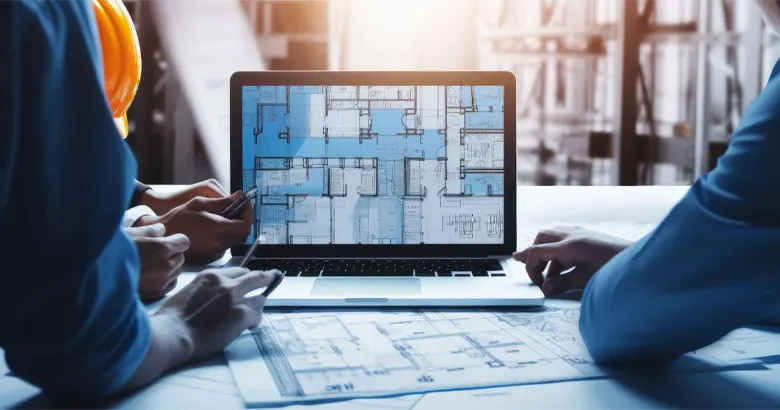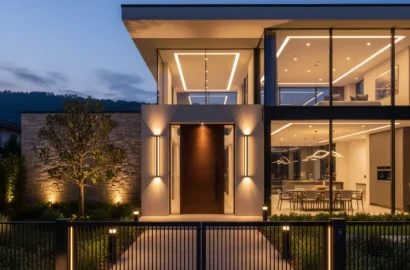This comprehensive guide covers all the steps needed to make a career transition from civil engineering to interior design. We cover the overlap of skills between the fields as well as the courses and programs that can help you achieve a smooth transition.
In today’s job market, career transitions are becoming more common as professionals seek new challenges and fulfillment. A transition from civil engineering to interior design is appealing because it allows individuals to combine their technical expertise with creative expression.
More importantly, for civil engineers, the knowledge and skills acquired in their field can be effectively transferred to interior design, opening up new career opportunities. In this article, we’ll explore why civil engineers make excellent interior designers, the steps to facilitate this career change, and the courses and training programs that can help you succeed.
Contents:
- Why do civil engineers make great interior designers?
- Steps to Transition from Civil Engineering to Interior Design
- Next Steps
Why do civil engineers make great interior designers?
Civil engineers possess a set of technical skills and abilities that align perfectly with the requirements of interior design. Nonetheless, there are plenty of other reasons why civil engineers might find it easier to transition into the field of interior design compared to professionals looking to switch from a different field. Let’s delve into the specific reasons why they are well-suited for this transition.
1. Overlap
Civil engineers have a strong understanding of structures, materials, and project management, all of which are crucial elements in interior design. Their expertise in these areas ensures the designs they create are both aesthetically pleasing and structurally sound.

2. Creative and Technical Balance
Both civil engineering and interior design require a mix of creativity and technical knowledge. Civil engineers’ ability to design and oversee the construction of infrastructure can translate into innovative and practical interior design solutions.
3. Problem-Solving Abilities
Problem-solving is central to both fields. Civil engineers address complex structural challenges, while interior designers solve spatial and design problems. This shared skill set is vital for creating functional and beautiful interior spaces.
4. Attention to Detail
Both professions demand a high level of precision and attention to detail. Civil engineers’ meticulous approach ensures that every element of a project aligns perfectly with the end goal, making them well-suited for interior design tasks.
6 Steps to Transition from Civil Engineering to Interior Design
Transitioning from civil engineering to interior design involves several steps, each of which plays a crucial role in ensuring a successful shift. Here’s a detailed guide to help you through this process.
1. Assessing Your Interests and Strengths
The first step in making a successful career transition is self-assessment. Here are a few things you should do in this regard:
- Identify Your Passion: Assess whether you have a genuine interest in interior design, as passion is crucial for sustained success.
- Evaluate Your Skills: Consider how your engineering skills, such as project management, technical drawing, and problem-solving, can be creatively applied to interior design.
- Seek Feedback: Talk to professionals in both fields to get insights into interior designers’ daily responsibilities and challenges.
2. Gaining Experience
Practical experience is essential to build credibility and expertise in interior design. Here are some ways to gain valuable experience:
- Internships: Apply for internships with interior design firms to gain hands-on experience and industry knowledge.
- Volunteer Opportunities: Volunteer for non-profit organizations or community projects that involve interior design work.
- Freelance Projects: Start with small freelance projects to build your portfolio and gain practical experience.
3. Continuing Education
Staying updated with industry trends and expanding your knowledge is vital for success in interior design. Consider these educational opportunities:
- Design Courses: Enroll in interior design courses that cover the fundamentals – design principles, colour theory, space planning, and more.
- Workshops: Participate in workshops on the latest interior design software and techniques.
- Certifications: Obtain certifications from recognized institutions to enhance your credentials.
4. Building a Portfolio
A well-crafted interior design portfolio is crucial for showcasing your design capabilities and engineering background. Here’s how to build an impressive portfolio:
- Diverse Projects: Include a range of projects demonstrating your design versatility and creativity.
- Visual Presentation: Use high-quality images, sketches, and CAD drawings to present your work professionally.
- Project Descriptions: Provide detailed descriptions of each project, highlighting your role, the challenges faced, and the solutions implemented.
5. Networking and Mentorship
Building a professional network and finding a mentor can significantly impact your career transition. Here are some steps to take:
- Join Professional Organisations: Become a member of organizations such as the American Society of Interior Designers (ASID) to connect with industry professionals.
- Attend Industry Events: Participate in design expos, conferences, and networking events to meet potential mentors and collaborators.
- Seek Mentorship: Find a mentor who can provide guidance, advice, and support as you navigate your new career path.
6. Exploring Different Design Styles
Understanding various design interior design styles will help you find your niche and cater to diverse client preferences. Here’s how to explore different styles:
- Research: Study different design styles, such as modern, contemporary, traditional, and minimalist, to understand their characteristics.
- Experiment: Experiment with different styles in your projects to discover your unique design aesthetic.
- Client Feedback: Seek feedback from clients and colleagues to refine your style and approach.
What To Look For in An Interior Design Course?
Enrolling in design courses and training programs will help you bridge the gap between civil engineering and interior design. Consider enrolling in courses that cover the fundamentals of the discipline while also keeping you up-to-date with the latest trends in the industry.
Here are a few things you should look for when evaluating course curriculums:
- Fundamental Design Principles: Look for courses that teach the basics of design, including color theory, spatial arrangement, and aesthetic principles.
- Computer-Aided Design (CAD): CAD courses are essential for learning how to create precise and detailed design plans using industry-standard software.
- Space Planning: Understanding space planning is crucial for designing functional and efficient interior layouts.
- Materials and Finishes: Courses on materials and finishes will help you understand the properties and applications of different materials in interior design.
AND Academy offers advanced online interior design courses for various skill levels. The education philosophy at AND goes beyond mastering software to understanding interior design principles which in turn lays a lot of emphasis on a hands-on learning approach to teaching.
AND learners are taught by industry experts who provide guidance, share insights from their extensive experience, and help students grasp industry trends and best practices. By choosing AND, you learn to think like a designer, making it an ideal choice for transitioning from civil engineering to interior design.
Next Steps
We hope this article has left you with some actionable tips to help you seamlessly transition from civil engineering to interior design. You can also check out the journey of AND student who has achieved this transition of becoming an interior designer from a civil engineer. If you would like to get a leg up on your learning journey, we recommend you read our expertly drafted articles on interior design in our resource section.
Here are some additional resources to help you in your learning process:
- Watch this session by Snehanshu Mukherjee, Founding Partner at T.E.A.M, and Mansi Almadi, an Interior Designer at Studio Lotus
- Talk to a course advisor to discuss how you can transform your career with one of our courses.
- Check out our Interior Design courses – all courses are taught through live, interactive classes by industry experts.
- Take advantage of our scholarship and funding options to overcome any financial hurdle on the path of your career transformation.
Note: All information and/or data from external sources is believed to be accurate as of the date of publication.









